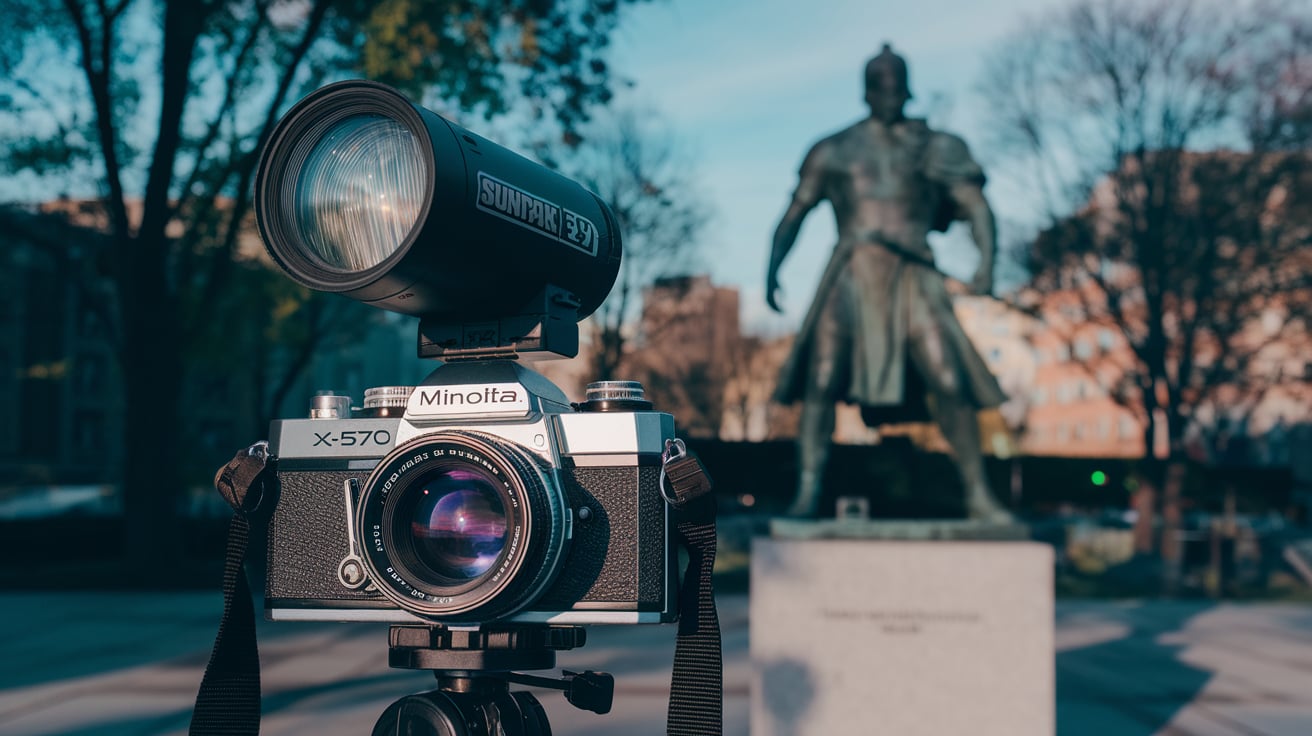Introduction to Minolta XGA and Flash Usage
The Minolta XGA is a prominent model in the realm of film cameras, particularly known for its blend of advanced features and user-friendly design. As a part of the Minolta X-series, this camera encompasses a variety of attributes, such as its lightweight body, interchangeable lenses, and a reliable metering system, which caters to both novice and experienced photographers. This model is highly regarded for its capability to produce high-quality images, allowing users to explore their creative skills while maintaining exceptional photographic standards.
One essential aspect of photography that significantly enhances image quality is the use of flash. This feature is particularly important in low-light conditions, where natural light may be insufficient to capture clear and vivid photographs. Utilizing flash can effectively illuminate subjects, reduce shadows, and improve overall image brightness, thereby contributing to better exposure. In the context of the Minolta XGA, understanding how to effectively sue flash can optimize photo results, making it an imperative skill for photographers aiming to achieve professionalism in their craft.
Moreover, the versatility of the Minolta XGA allows for a range of flash options, from built-in flashes to external flash units. Each option presents unique advantages, and knowing how to properly configure them can result in dramatic enhancements in photographic output. This guide will offer insights and techniques on how to sue flash in Minolta XGA, covering various scenarios and providing practical recommendations that photographers can apply to enrich their shooting experience. By mastering the use of flash with this camera, photographers can significantly expand their creative possibilities, irrespective of the environmental lighting conditions.
Understanding Flash Functions in Minolta XGA
The Minolta XGA camera provides various flash functions that enhance photographic versatility and allow for creative expression under a range of lighting conditions. Understanding these flash options will enable photographers to make better choices while capturing images. The camera is equipped with a built-in flash, which offers convenient and immediate solutions for low-light scenarios. However, for those seeking greater control and enhanced lighting quality, utilizing external flash options is highly advantageous. External flashes complement the built-in system by allowing for better synchronization with the subject and the environment, ensuring improved light diffusion and reducing harsh shadows.
In addition to choosing between built-in and external flash, photographers must also familiarize themselves with the different flash modes available on the Minolta XGA. The auto flash mode is designed to determine when additional light is needed, thus allowing for stress-free shooting in various conditions. Photographers can rely on this mode for regular snapshots, as it functions effectively in most scenarios. Another significant mode is the red-eye reduction feature. This mode emits a pre-flash before the main flash, helping to minimize the occurrence of red-eye in photographs—a critical function for portraits or group shots.
Fill flash mode is also noteworthy, as it fills in shadows caused by strong backlighting. This mode is particularly useful in outdoor photography, where subjects may often be partially obscured by bright backgrounds. By employing fill flash, photographers can enhance the details of their subjects, leading to more balanced and visually appealing images. Overall, grasping these flash functions in the Minolta XGA provides photographers with essential tools for enhancing their image quality and achieving desired photographic outcomes.
Setting Up Flash on Minolta XGA
Setting up the flash on your Minolta XGA is essential for achieving well-lit photographs, especially in low-light conditions. To begin, ensure that your camera is powered on. Locate the flash button, typically found on the camera body or within the menu settings of the Minolta XGA. Press the button to activate the built-in flash or to ready an external flash unit, if one is being used.
After powering on the flash, you will want to adjust the flash settings to suit your shooting environment. The Minolta XGA provides options to modify the flash power output. Using the camera’s menu, navigate to the flash settings section, where you can increase or decrease the intensity of the flash. It is important to choose an appropriate flash power to avoid overexposing or underexposing your image, as this can significantly affect the outcome of your shots.
Synchronization is another critical aspect of using the flash. Ensure that your flash is set to sync with the camera shutter. This setting may typically be found in the same flash menu. Consider using slow synchronization for nighttime photography or backlit subjects, while using normal sync for most everyday shooting. By doing so, you enhance your chances of capturing striking images even in challenging lighting situations.
Before taking any shots, a practical tip is to perform a test flash to confirm everything is functioning correctly. This simple step can save a lot of time and prevent missed photographic opportunities. Remember to check if the flash is ready, indicated by a signal light on the flash unit. With these steps on how to sue flash in Minolta XGA, you are well-equipped to make the most of your photography sessions.
Tips for Effective Flash Photography
Mastering the art of flash photography is essential for achieving high-quality images, particularly when using the Minolta XGA. One key aspect of how to sue flash in Minolta XGA is proper positioning. Placing the flash at an angle rather than directly in front of the subject can create more dynamic lighting effects. This technique helps to reduce harsh shadows and enhances the overall depth of the photograph.
Another effective strategy involves using diffusion techniques to soften the light produced by the flash. Utilizing a diffuser, such as a softbox or a simple piece of white fabric, can effectively disperse the light, resulting in a more flattering illumination of your subject. This is particularly beneficial when photographing portraits or close-up shots, where smooth and natural lighting is crucial. Adjusting the intensity and direction of the flash will also contribute to achieving the desired softness.
Understanding the distance between the flash and your subject is another important factor. If the flash is positioned too far away, the exposure may be too dim, whereas being too close can cause overexposure and an unnatural appearance. A balanced distance should be maintained to ensure the light is effective without washing out details. Additionally, consider the ambient light existing in the scene. Incorporating ambient light along with your flash can produce a more balanced and professional-looking image. This approach captures the essence of the scene while utilizing flash for crucial highlights.
In summary, effective flash photography using the Minolta XGA involves thoughtful positioning, diffusion of light, careful management of distance from the subject, and consideration of ambient light. By implementing these tips, you can enhance your photography skills and make the most of how to sue flash in Minolta XGA, leading to exceptional and vibrant images.
Common Problems and Troubleshooting
Photographers utilizing the Minolta XGA may encounter several common issues when integrating flash into their shooting routine. These problems, while frustrating, can often be resolved through systematic troubleshooting. One frequent issue is the flash not firing at all. This can stem from various sources, such as a dead battery in the flash unit, improper seating of the flash on the camera, or a faulty connection. To address this, first, verify that the battery is fully charged and properly installed in the flash. Then, ensure that the flash is securely attached to the Minolta XGA’s hot shoe. If these steps do not resolve the issue, it may be worthwhile to test the flash on another camera to rule out the possibility of a camera malfunction.
Another prevalent challenge faced by users is overexposed images when using flash with the Minolta XGA. This can occur if the flash output is too powerful relative to the aperture setting, ISO sensitivity, or the distance to the subject. To rectify this issue, begin by adjusting the flash output setting, if available, to a lower level. Additionally, check the camera’s settings; a smaller aperture (higher f-stop number) or a lower ISO can help mitigate overexposure. It is also advisable to consider the positioning of the flash unit; sometimes, bouncing the flash off a nearby surface can diffuse the light and reduce harsh shadows.
Lastly, underexposure may surprise some Minolta XGA users who expect balanced results. If the flash appears to be firing yet images still come out too dark, there could be several factors at play. Ensuring that the camera is set to use flash mode and that the shutter speed is appropriate for flash photography is crucial. Additionally, using exposure compensation might help achieve more balanced results. By recognizing these common problems and implementing the appropriate troubleshooting steps, photographers can significantly enhance their experience and results when learning how to sue flash in Minolta XGA, leading to more successful flash photography sessions.
Creative Uses of Flash in Photography
Flash in photography is often seen merely as a tool for providing additional light, but its applications can extend far beyond that function. By understanding how to sue flash in Minolta XGA creatively, photographers can produce images that are not only well-lit but also artistically compelling. Various techniques can be employed to add depth, dimension, and interest to a photograph.
One popular technique is the drag shutter, which involves using a slow shutter speed combined with a flash. By allowing the shutter to stay open longer, the photographer can capture motion blur while the flash freezes the action at a specific moment. This technique is particularly useful in dynamic environments, such as sports photography or during night scenes where movement is present. Mastering how to sue flash in Minolta XGA with drag shutter settings can result in striking photos that tell a story of movement.
Another innovative approach is stroboscopic flash photography, which utilizes a series of flashes in quick succession. This technique captures multiple points of motion in a single frame, allowing for creative expression in capturing fast-moving subjects. It is especially effective in dance or action photography, where the fluidity of movement can be elegantly illustrated. Understanding how to sue flash in Minolta XGA for stroboscopic effects empowers photographers to explore new visual narratives.

High-speed sync is another valuable technique that allows for the use of flash at faster shutter speeds. This can be particularly beneficial when trying to shoot with a wide aperture in bright conditions, enabling the photographer to maintain shallow depth of field while still allowing for creative illumination. By learning how to sue flash in Minolta XGA techniques like high-speed sync, photographers are equipped to handle challenging lighting conditions and enhance their creativity.
Comparative Analysis: Built-in Flash vs. External Flash
When it comes to utilizing flash photography with the Minolta XGA, understanding the differences between the built-in flash and external flash units can significantly influence the outcomes of your photographic efforts. Each option presents unique advantages and limitations that can affect the overall quality and effectiveness of your images.
The built-in flash of the Minolta XGA is a convenient feature for users who prioritize portability and ease of use. It is readily accessible, allowing photographers to quickly utilize it without the need for additional equipment. This flash typically provides sufficient illumination for close-range subjects, making it useful for casual shooting environments or scenarios where space and time are limited. However, its relatively low power output and fixed positioning may lead to harsh lighting or unflattering shadows, especially in larger settings or with distant subjects.
In contrast, external flash units offer enhanced versatility and performance. These units come equipped with higher power ratings, enabling them to illuminate subjects at greater distances and through larger depths of field. Additionally, external flashes often feature adjustable heads, allowing photographers to bounce light off walls or ceilings for softer illumination, thereby reducing the chance of shadows. They may also include advanced functionalities such as TTL (Through The Lens) metering, which optimizes exposure automatically based on the environment. However, using an external flash with the Minolta XGA entails additional considerations, such as the need for extra gear and potentially higher costs.
Ultimately, the choice between the built-in flash and an external flash unit will depend on the specific shooting scenarios and personal preferences of the user. For quick snapshots and everyday photography, the built-in flash may suffice; conversely, for more professional or detailed work, investing in an external flash to leverage its capabilities could be the wiser option. Balancing these factors will enable photographers to enhance their experience with the Minolta XGA.
Real-world Examples and Case Studies
Utilizing flash in photography can dramatically alter the quality and emotion of an image. The Minolta XGA, with its diverse settings and capabilities, allows photographers to experiment with flash under various conditions. Here, we will explore several real-world examples and case studies that showcase effective flash usage, enriching the understanding of how to sue flash in Minolta XGA.
One notable case involved a wedding photographer who struggled with inconsistent lighting. By incorporating the Minolta XGA’s built-in flash, the photographer managed to capture numerous candid moments without overwhelming the subjects or detracting from the natural ambience. The flash function was particularly useful during the indoor reception, where ambient light was limited. Supplementing the existing light enabled the photographer to maintain sharpness and highlight the details of the décor, enhancing the overall composition of the images.
Another compelling example can be found in wildlife photography. A photographer venturing into late afternoon shoots in a forest used the Minolta XGA’s flash to illuminate subjects against darker backgrounds. This technique effectively drew attention to the intricate features of small animals, such as birds or insects, that could otherwise be lost in shadows. By adjusting the flash output, the photographer controlled the luminosity to achieve a natural look, ensuring that the flash complemented the environment rather than overpowering it.
In sports photography, flash serves a crucial role in freezing action during nighttime events. A case study of a local soccer match demonstrated how the Minolta XGA could be deployed to capture dynamic movements and expressions. The photographer utilized the flash in combination with a high shutter speed to freeze the athletes in motion while maintaining clarity, resulting in vibrant photographs that conveyed the intensity of the game.
These examples illustrate the versatility and efficacy of using flash with the Minolta XGA across different photography genres. By applying these techniques, photographers can enhance their skills and outcomes in various situations, ensuring that they maximize their creative potential.
Conclusion: Mastering Flash Usage in Minolta XGA
In conclusion, mastering the use of flash in your Minolta XGA can significantly enhance the quality of your photographs, particularly in challenging lighting conditions. Understanding how to sue flash in Minolta XGA is essential for achieving well-exposed images, whether you are capturing portraits, landscapes, or events. Throughout this guide, we have explored various techniques and settings to optimize flash usage, allowing for creative and dynamic photography.
Key takeaways include the importance of balancing ambient light with flash exposure, knowing when to utilize fill flash, and adjusting the flash power to suit different scenarios. Practicing these techniques will boost your confidence and skill level in manipulating light effectively. It is crucial to experiment with different settings, as each lighting condition may require a unique approach to achieve the desired results.
Additionally, understanding the functionality of the Minolta XGA’s flash features, such as the bounce and swivel capabilities, can open up new creative possibilities. Incorporating indirect lighting can soften harsh shadows and produce more flattering images, particularly in portrait photography. As you develop your skills, do not hesitate to analyze your work critically and adjust your techniques accordingly.
By integrating these strategies into your photographic practice, you will not only improve the technical aspects of your images but also enrich your artistic expression. Embrace the journey of learning how to sue flash in Minolta XGA; with time and experience, your proficiency will grow, ultimately leading to stunning photographic outcomes that captivate your audience.
you may also read


